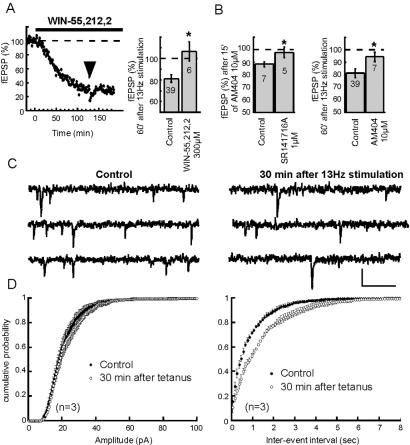Figure 2.
eCB-LTD is occluded by CB1 activation and is presynaptic. (A) Typical experiment (time course) and group data (histogram) where the CB1 agonist WIN 55,212,2 (300 nM) occluded eCB-LTD. In the presence of WIN 55,512,2 fEPSP measured 106.7 ± 8.8% of baseline, 60 min after LTD-induction; n = 6, P < 0.05 vs. control without WIN 55,212,2. (B) The eCB transporter blocker AM-404 inhibits fEPSP in a SR141716A-sensitive manner (fEPSP measured 88.4 ± 2.2% of baseline 15 min after AM-404 application, n = 7, and 97.9 ± 4.2% in the presence of SR141716A, n = 5, P < 0.05) and partially occludes eCB-LTD. In the presence of AM-404, fEPSP measured 94.5 ± 3.9% of baseline 60 min after tetanus, n = 7, P < 0.06 vs. control without AM-404. (C) Representative consecutive 1-sec current sweeps from a cell where sEPSCs were recorded in control and 30 min after tetanic stimulation. (Bar = 30 pA, 200 msec.) (D) sEPSC amplitude distribution was unchanged (n = 3, Kolmogorov–Smirnof test, P > 0.001). On the contrary, the distribution of the time intervals between successive sEPSCs in these neurons shows a reduction of sEPSC frequency after tetanus (Kolmogorov–Smirnof test P < 0.0001).

